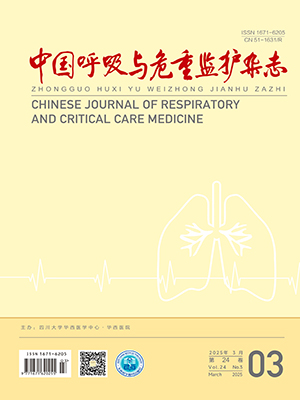| 1. |
中华医学会呼吸病学分会慢性阻塞性肺疾病学组, 中国医师协会呼吸医师分会慢性阻塞性肺疾病工作委员会. 慢性阻塞性肺疾病诊治指南(2021 年修订版). 中华结核和呼吸杂志, 2021, 44(3): 170-205.
|
| 2. |
Wang C, Xu J, Yang L, et al. Prevalence and risk factors of chronic obstructive pulmonary disease in China (the China Pulmonary Health study): a national cross-sectional study. Lancet, 2018, 391(10131): 1706-1717.
|
| 3. |
Zhou M, Wang H, Zeng X, et al. Mortality, morbidity, and risk factors in China and its provinces, 1990-2017: a systematic analysis for the Global Burden of Disease Study 2017. Lancet, 2019, 394(10204): 1145-1158.
|
| 4. |
Hikichi M, Mizumura K, Maruoka S, et al. Pathogenesis of chronic obstructive pulmonary disease (COPD) induced by cigarette smoke. J Thorac Dis, 2019, 11(Suppl 17): S2129-S2140.
|
| 5. |
曾金, 张志荣, 缪萍, 等. 隐丹参酮的药理作用研究进展. 中成药, 2015, 37(6): 1309-1313.
|
| 6. |
Liu H, Zhan X, Xu G, et al. Cryptotanshinone specifically suppresses NLRP3 inflammasome activation and protects against inflammasome-mediated diseases. Pharmacol Res, 2021, 164: 105384.
|
| 7. |
Wang N, Dong X, Shi D, et al. Cryptotanshinone ameliorates placental oxidative stress and inflammation in mice with gestational diabetes mellitus. Arch Pharm Res, 2020, 43(7): 755-764.
|
| 8. |
Tang Y, Chen YL, Chu Z, et al. Protective effect of cryptotanshinone on lipopolysaccharide-induced acute lung injury in mice. Eur J Pharmacol, 2014, 723: 494-500.
|
| 9. |
Li J, Zheng M, Wang C, et al. Cryptotanshinone attenuates allergic airway inflammation through negative regulation of NF-κB and p38 MAPK. Biosci Biotechnol Biochem, 2020, 84(2): 268-278.
|
| 10. |
Wu YH, Wu YR, Li B, et al. Cryptotanshinone: A review of its pharmacology activities and molecular mechanisms. Fitoterapia, 2020, 145: 104633.
|
| 11. |
Barnes PJ. Targeting cytokines to treat asthma and chronic obstructive pulmonary disease. Nat Rev Immunol, 2018, 18(7): 454-466.
|
| 12. |
向斌, 王玮, 郑劲平. 慢性阻塞性肺疾病气道黏液高分泌研究进展. 国际呼吸杂志, 2019, 39(20): 1566-1571.
|
| 13. |
饶敏, 陆月明. NF-κB 信号途径在 COPD 中的研究进展. 国际呼吸杂志, 2017, 37(21): 1641-1645.
|
| 14. |
Zhang P, Liu MC, Cheng L, et al. Blockade of LOX-1 prevents endotoxin-induced acute lung inflammation and injury in mice. J Innate Immun, 2009, 1(4): 358-365.
|
| 15. |
Zou XZ, Gong ZC, Liu T, et al. Involvement of epithelial-mesenchymal transition afforded by activation of LOX-1/TGF-β1/KLF6 signaling pathway in diabetic pulmonary fibrosis. Pulm Pharmacol Ther, 2017, 44: 70-77.
|
| 16. |
Wu Z, Sawamura T, Kurdowska AK, et al. LOX-1 deletion improves neutrophil responses, enhances bacterial clearance, and reduces lung injury in a murine polymicrobial sepsis model. Infect Immun, 2011, 79(7): 2865-2870.
|
| 17. |
Deng W, Deng Y, Deng J, et al. Losartan attenuated lipopolysaccharide-induced lung injury by suppression of lectin-like oxidized low-density lipoprotein receptor-1. Int J Clin Exp Pathol, 2015, 8(12): 15670-15676.
|
| 18. |
Ge X, Zhang DM, Li MM, et al. Microglial LOX-1/MAPKs/NF-κB positive loop promotes the vicious cycle of neuroinflammation and neural injury. Int Immunopharmacol, 2019, 70: 187-200.
|
| 19. |
李俊峰, 王重阳, 徐畅, 等. 隐丹参酮通过抑制 p38 MAPK/NF-κB 通路改善哮喘气道炎症. 中药新药与临床药理, 2020, 31(1): 15-20.
|




